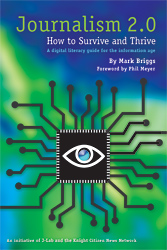A digital literacy guide for the information age

Reported by Mark Briggs
Edited by Jan Schaffer
Foreword by Phil Meyer
Introduction by Mark Briggs
Credits
Journalism 2.0: How to Survive and Thrive
A digital literacy guide for the information age
By Mark Briggs, former Assistant Managing Editor for Interactive News, The News Tribune
Special thanks to The Knight Foundation for its support of this work.
Thanks to J-Lab Executive Director Jan Schaffer for her guidance and editing; to former washingtonpost.com editor Steve Fox for his skillful input and editing; and to J-Lab’s Craig Stone for his copyediting, Web production and publishing help. Read the rest of the acknowledgments.
(c) 2007
J-Lab: The Institute for Interactive Journalism
Philip Merrill College of Journalism, University of Maryland, College Park
Chapter 1: FTP, MB, RSS, Oh My
- Introduction: Today’s special? Acronym soup
- Digital information: Megabytes, Gigabytes and Terabytes
- How the Internet works
- About Web browsers
- RSS readers and feeds
- RSS basics
- Instant messaging
- File Transfer Protocol
- Welcome to Web 2.0
- Web 2.0 is all about openness, organization and community
- Tags and folksonomy: New ways to organize content
- Can you Digg it?
- What does this mean for journalism?
- Don’t know where this is heading?
- Introduction
- Tools you should be using
- Mobile 2.0
- iPod: The slim, sleek 800-pound gorilla
- ‘Other’ wireless
Chapter 4: New Reporting Methods
- Introduction
- Spreadsheets and storing data
- Your ‘so-called digital life’
- Crowdsourcing
- Distributed, collaborative or open-source reporting
- Summary
- Introduction
- What is a blog?
- Getting started
- Terminology
- Mechanics
- Frequency and handling comments
- Using photos and screenshots
- Love it or leave it
Chapter 6: How to Report News for the Web
- Introduction
Chapter 7: Digital Audio and Podcasting
- Introduction
- The basics: Audio formats
- Identifying opportunities
- Buying a recorder
- Using a microphone
- Recording with your computer
- Editing your audio
- Using time points for speed
Chapter 8: Shooting and Managing Digital Photos
- Introduction
- The basics
- Shooting basic photos with a digital camera
- Editing photographs digitally
- Summary
Chapter 9: Shooting Video for News and Feature Stories
- Introduction
- Digital video cameras
- Tapes, batteries and other accessories
- Zooming, focusing and exposure
- Get good audio
- Shooting the video
- As simple as it gets
- Do a trial run
Chapter 10: Basic Video Editing
- Introduction
- For Mac users: iMovie
- For PC users: Windows Movie Maker
Chapter 11: Writing Scripts, Doing Voice-overs
- Introduction
- Interviewing while recording
- Voice-overs
- On-camera standup
Epilogue: Putting It All Together
- Script for Hurricane Family Feature
